 |
 |
 |
| |
Acute hepatitis C infection in HIV negative men who have sex with men......in UK - 'sexual HCV transmission/risky sex & drug use behavior/low rates of screening/routine screening recommended for these risk group'
|
| |
| |
Reported by Jules Levin
54th ICAAC Sept 5-8 2014 Wash DC
"In conclusion...We know HIV negative MSM are at risk of HCV infection as they engage in the same risk behaviours as HIV positive MSM. A minority of our cohort report injection and nasal drug use, supporting the hypothesis for sexual transmission of hepatitis C in HIV negative MSM. We identified low rates of HCV screening for an at risk MSM population attending sexual health services. We are concerned for un-diagnosed HCV infection and subsequent risk of onward transmission. We suggest hepatitis C testing should form a routine part of sexual health screening in all Individuals with risk factors as described, and particularly in environments with high hepatitis C prevalence. Future directions within our clinic should include accurate history taking, accurate documentation of all drug use, and as Kimberley Workowski put it yesterday, "getting real with our patients", that is, asking penetrating questions about penetrating activities. In this way, we hope to accurately gauge the magnitude of hepatitis C within all our MSM patients and deliver better care to an at risk population."
Many thanks to the organisers of ICAAC for inviting me here to present this work to you today.
· My name is Katie McFaul... and I am a fellow in HIV medicine at Chelsea and Westminster Hospital, London.
· I am here to present our work... on Acute hepatitis C infection in HIV negative men who have sex with men.
Men who have sex with men are now recognized as a group at risk of hepatitis C infection and throughout the course of this talk will be referred to as "MSM". We are all aware of traditional routes of hepatitis C acquisition- injecting drug use and parenteral transmission but sexual transmission has become relevant, particularly in HIV infected MSM and incidence has increased 10-fold to since year 2000.
Factors relevant to transmission include traumatic sexual practices and ulcerative sexually transmitted infections such as chlamydia and gonorrhea, increased numbers of sexual partners and those who engage in intravenous drug use.
Hepatitis C prevalence in HIV negative MSM is less well described, possibly as they are not traditionally covered in screening recommendations unless specific risks apply. HIV-negative MSM have lower reported rates of HCV infections than HIV positive MSM, We know from talking to our HIV negative MSM that similar risks apply
We wanted to perform a retrospective review of all HIV negative MSM diagnosed with acute hepatitis C as defined by European AIDS networl criteria- which I will discuss in the methods- and to review our institution's rates of hepatitis C screening. Our institution has clinics on 3 sites and serves a large urban area in central and west London. We extracted data on all HIV negative MSM attending sexual health services from January 2010 to May 2014.
NEAT criteria were applied to determine if the infection was acute. The patient had to have a positive HCV antibody or HCV RNA, with a previously documented negative HCV antibody or HCV RNA within the previous 12 months or an alanine aminotransferase rise of greater than ten times the upper limit of normal or five times with a previously normal ALT in the last 12 months. For a clinical diagnosis, patients had to have signs and symptoms consistent with acute hepatitis C; jaundice, nausea, dark urine, right upper quadrant pain, fatigue, low-grade fever and systemic symptoms.
We identified 44 patients as having acute hepatitis C-15 who met antibody criteria, 11 who met alanine aminotransferase criteria and 18 who were classified as clinical hepatitis C on symptom presentation
We collected Information on demographics, alcohol intake, recreational drug use, partner's serology if known, sexual behaviours including high risk activities such as group sex, fisting, multiple sexual partners, presence of co-infection with a sexually transmitted infection at diagnosis, hepatitis B immunity status, hepatitis C outcomes and treatment details were recorded.
From this group of 44 patients we looked at their baseline hepatitis C characteristics. The median age was 37 years (range 24 - 75), the median amount of partners within the last 3 months was 2 with a range of zero to 100, median baseline HCV RNA was 5.47 log10, median ALT was 88. Genotype was available in 22 patients. 19 were genotype 1,1 genotype 3 and 2 genotype 4.
· We looked at HIV testing in this group and the median time between diagnosis of HCV to HIV testing was 0 days with a range of zero to 28 days.
We then looked at individual risk factor for our group of 44 patients. The majority practiced anal sex, both insertive and receptive. 1 third of this group engaged in high risk sexual practices.. group sex, fisting activities... and "chem sex". For the uninitiated, chem sex refers to the use of recreational drugs whilst having sex. Drugs used include cocaine, ketamine, gamma hydroxybutyrate, mephedrone and crystal methamphetamine. This is becoming a significant factor in the sexual health of MSM and is something we see a lot of, particularly in our Soho based clinic, with many MSM reporting use at last sexual encounter. Chem sex also reduced safe sex measures with 31.4% of this group reported ever engaging in unprotected sex whilst under the influence of recreational drugs. Recreational drug use at any time was reported by half of the group; 16 reporting nasal use and 9 of this group reported injecting drug use. This, in particular, supports successful sexual transmission of hepatitis C with HIV negative MSM, as the majority of this group did not inject drugs. Individuals were asked if they knew their regular partners' serology. Of 30 inidividuals in whom the question was asked, 2 had contact with a known HCV monoinfected partner, 13 with a HIV monoinfected partner, 6 with a HCV/HIV coinfected partner and 9 were unaware of their partner's serostatus. Data on presence of sexually transmitted infections at diagnosis was recorded. 13 patients had a sexually transmitted infection; 7 gonorrhea, 3 chlamydia, 2 gonorrhea chlamydia coinfection. 3 patients had syphilis- 2 were coinfections
Outcomes were reviewed. 15 patients achieved spontaneous clearance of AHC, none of whom had documented evidence of subsequent reinfection. 10 patients were successfully treated. 13 remain under observation and 6 patients were lost to followup.
We recorded data on pre and post exposure HIV prophylaxis. 8 of our patients had received HIV post-exposure prophylaxis (PEP) within the six months prior to AHC diagnosis. 2 patients were participants in a HIV pre-exposure prophylaxis trial. We looked at followup HIV testing in these patients. 35 of 44 patients had subsequent HIV testing within the department and remain negative. Median time from their last test until the present is 4.5 months with a range of zero to 20 months. 9 patients did not present for further HIV tests.
We then looked at our rate of hepatitis C screening on a directorate level. We selected a typical month to review HCV screening in HIV-negative MSM. In November 2013, 3811 HIV negative MSM attended this sexual health service. Only 14.8% (565/3810) had HCV testing with either HCV RNA or HCV antibody.
We know that our directorate performed 11608 sexual health screens performed in September 2013. 41.9%, the majority, were in HIV negative MSM, 4.3% were in HIV positive MSM and 37.6% were in HIV negative MSM
From this figure, we estimate 623,350 sexual health screens were done during our lookback period of January 2010 to May 2014. If we assume similar attendance frequencies for HIV negative MSM, this equates to 261,036 attendances. As our current HCV screening rate is 14.8%, this means 34,657 HIV negative MSM screened for HCV, and leaves 199,618 who were not screened for HCV.
In conclusion...We know HIV negative MSM are at risk of HCV infection as they engage in the same risk behaviours as HIV positive MSM. A minority of our cohort report injection and nasal drug use, supporting the hypothesis for sexual transmission of hepatitis C in HIV negative MSM. We identified low rates of HCV screening for an at risk MSM population attending sexual health services. We are concerned for un-diagnosed HCV infection and subsequent risk of onward transmission. We suggest hepatitis C testing should form a routine part of sexual health screening in all Individuals with risk factors as described, and particularly in environments with high hepatitis C prevalence. Future directions within our clinic should include accurate history taking, accurate documentation of all drug use, and as Kimberley Workowski put it yesterday, "getting real with our patients", that is, asking penetrating questions about penetrating activities. In this way, we hope to accurately gauge the magnitude of hepatitis C within all our MSM patients and deliver better care to an at risk population.

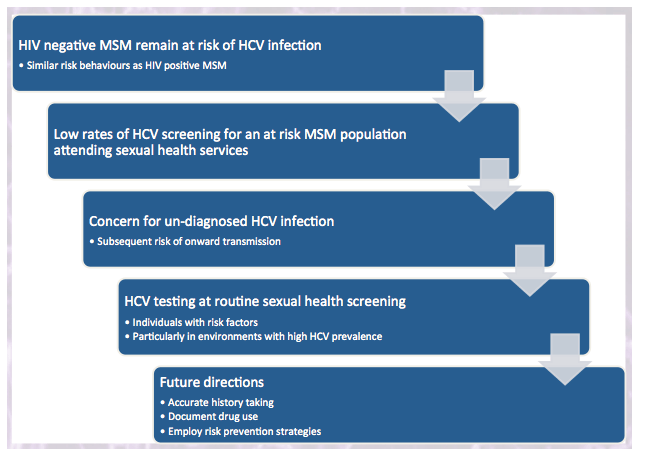
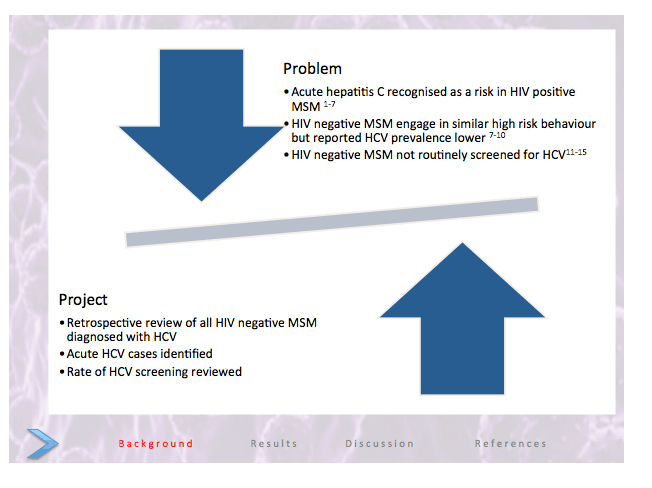

Program Abstract:
Background: Acute hepatitis C (AHC) infection is recognised in HIV infected men who have sex with men (MSM) but risk in HIV negative MSM remains unclear. We evaluated a population of MSM diagnosed with AHC in an urban sexual health clinic.
Methods: From January 2010 to December 2013, all cases of HCV antibody positive (Ab) HIV negative MSM were identified. European AIDS Network (NEAT) criteria were applied to determine acute infection.
Results: 45 individuals fulfilled acute hepatitis C criteria. 10 were RNA negative at baseline and classed as prior spontaneous clearance (SC). 3 had follow-up HCV RNA and remained RNA negative. 35 patients were viraemic; 15 with previously negative HCV Ab within 1 year, 17 with significant ALT elevation, and 3 with a clinical diagnosis. Median age at diagnosis was 37 years (range 24- 56). 82.9% reported unprotected anal sex, 34.3% group sex, 31.4% fisting. 27.8% had a sexually transmitted infection (STI) at HCV diagnosis- 4 gonorrhoea, 4 chlamydia, 1 gonorrhoea/chlamydia, and 2 syphilis. 75% patients were hepatitis B immune. 58.3% patients had documented recreational drug use (25.0% injection and 44.4% nasal use)- cocaine, GHB, mephedrone, crystal methamphetamine and ketamine. 31.4% engaged in sex whilst using recreational drugs. 5 further patients achieved SC. 10 patients received treatment; 7 achieved sustained viral response. 1 (2.9%) patient had a HCV -infected partner, 11 (31.4%) had HIV-positive partners, and 6 (17.1%) had HIV/HCV coinfected partners. 9 (25.7%) patients received HIV post-exposure prophylaxis (PEP) in the 6/12 prior to AHC diagnosis, 2 (5.7%) were in a pre-exposure prophylaxis study, and 24 (68.8%) had no PEP information documented HCV screening in HIV-negative MSM was reviewed. During November 2013, 3811 HIV negative MSM attended sexual health services. Only 14.8% (565/3810) had a HCV test (HCV RNA or HCV antibody).
Conclusions: Similar to the ongoing epidemic of AHC in HIV+ MSM, AHC is a problem for HIV negative MSM who have similar risks. HCV testing must be considered as a crucial part of sexual health screening in environments where risk factors or outbreaks of HCV exist. Accurate history taking, documentation of drug use and risk prevention messages are crucial in this high-risk population.
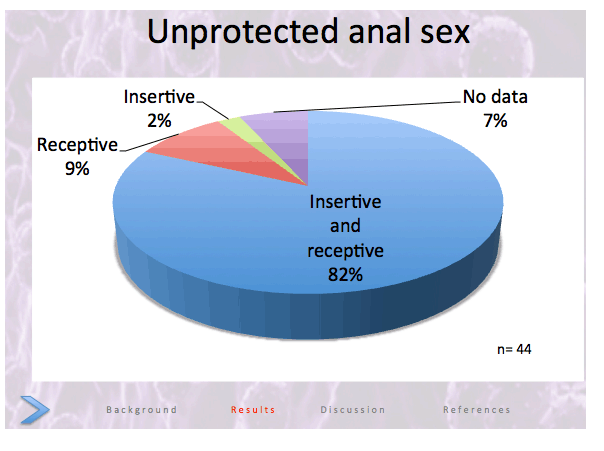



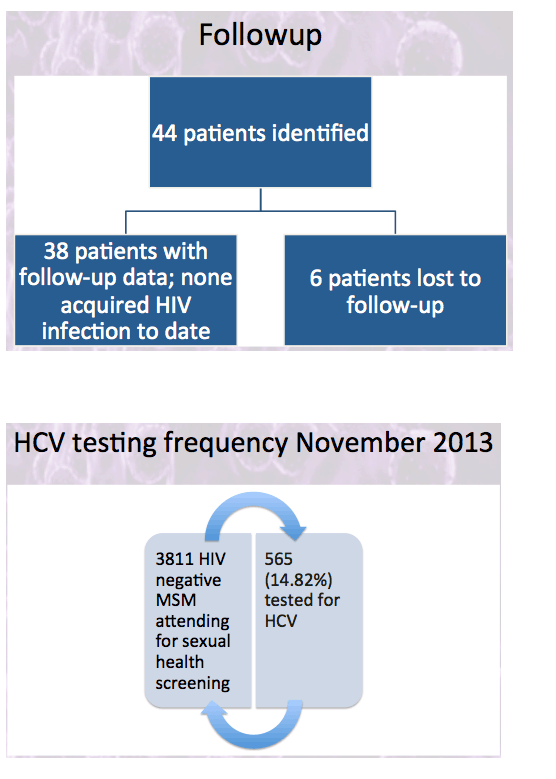
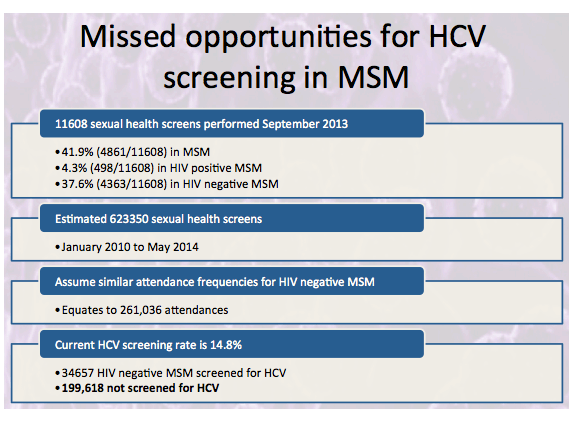
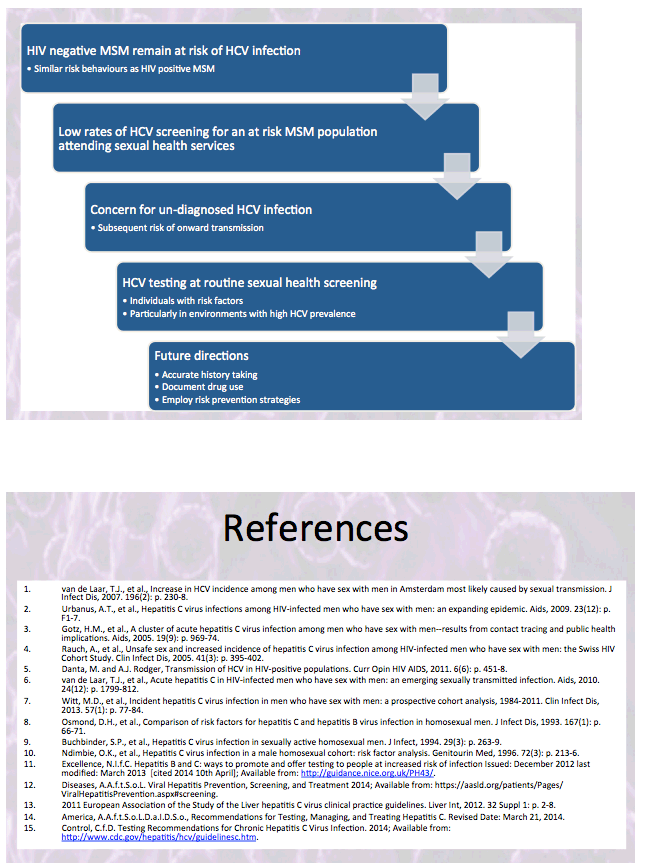
|
| |
|
 |
 |
|
|